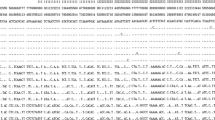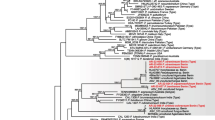Abstract
For a long time, classification of Demodex mites has been based mainly on their hosts and phenotypic characteristics. A new subspecies of Demodex folliculorum has been proposed, but not confirmed. Here, cox1 partial sequences of nine isolates of three Demodex species from two geographical sources (China and Spain) were studied to conduct molecular identification of D. folliculorum. Sequencing showed that the mitochondrial cox1 fragments of five D. folliculorum isolates from the facial skin of Chinese individuals were 429 bp long and that their sequence identity was 97.4%. The average sequence divergence was 1.24% among the five Chinese isolates, 0.94% between the two geographical isolate groups (China (5) and Spain (1)), and 2.15% between the two facial tissue sources (facial skin (6) and eyelids (1)). The genetic distance and rate of third-position nucleotide transition/transversion were 0.0125, 2.7 (3/1) among the five Chinese isolates, 0.0094, 3.1 (3/1) between the two geographical isolate groups, and 0.0217, 4.4 (3/1) between the two facial tissue sources. Phylogenetic trees showed that D. folliculorum from the two geographical isolate groups did not form sister clades, while those from different facial tissue sources did. According to the molecular characteristics, it appears that subspecies differentiation might not have occurred and that D. folliculorum isolates from the two geographical sources are of the same population. However, population differentiation might be occurring between isolates from facial skin and eyelids.
Similar content being viewed by others
References
Avise, J.C., Walker, D., 1999. Species realities and numbers in sexual vertebrates: perspectives from an asexually transmitted genome. PNAS, 96(3):992–995. [doi:10.1073/pnas.96.3.992]
de Rojas, M., Riazzo, C., Callejón, R., Guevara, D., Cutillas, C., 2012a. Morphobiometrical and molecular study of two populations of Demodex folliculorum from humans. Parasitol. Res., 110(1):227–233. [doi:10.1007/s00436-011-2476-3]
de Rojas, M., Riazzo, C., Callejon, R., Guevara, D., Cutillas, C., 2012b. Molecular study on three morphotypes of Demodex mites (Acarina: Demodicidae) from dogs. Parasitol. Res., 111(5):2165–2172. [doi:10.1007/s00436-012-3067-7]
Desch, C., Nutting, W.B., 1972. Demodex folliculorum (Simon) & D. brevis akbulatova of man: redescription and revaluation. J. Parasitol., 58(1):169–177. [doi:10.2307/3278267]
Hebert, P.D.N., Ratnasingham, S., de Waard, J.R., 2003. Barcoding animal life: cytochrome c oxidase subunit I divergences among closely related species. Proc. R. Soc. B., 270(s1):S96–S99. [doi:10.1098/rsbl.2003.0025]
Kumar, S., Nei, M., Dusley, J., Tamura, K., 2008. MEGA: a biologist centric software for evolutionary analysis of DNA and protein sequences. Brief. Bioinform., 9(4): 299–306. [doi:10.1093/bib/bbn017]
Li, C.P., 2009. Medical Arthropodology. People’s Medical Publishing House, Beijing, China (in Chinese).
Liu, S.F., Chen, L.L., Dai, F.Q., Zhuang, Z.M., 2010. Application of DNA barcoding gene cox1 for classifying family Sciagenidae. Oceanol. Limnol. Sin., 41(2):223–231 (in Chinese).
Morsy, T.A., el Okbi, M.M., el Said, A.M., Arafa, M.A., Sabry, A.H., 1995. Demodex (follicular mite) infesting a boy and his pet dog. J. Egypt. Soc. Parasitol., 25(2):509–512.
Perna, N.T., Kocher, T.D., 1995. Patterns of nueleotide composition at fourfold degenerate sites of animal mitochondrial genomes. J. Mol. Evol., 41(3):353–358. [doi:10.1007/BF01215182]
Ravera, I., Altet, L., Francino, O., Bardagí, M., Sánchez, A., Ferrer, L., 2011. Development of a real-time PCR to detect Demodex canis DNA in different tissue samples. Parasitol. Res., 108(2):305–308. [doi:10.1007/s00436-010-2062-0]
Tamura, K., Dudley, J., Nei, M., Kumar, S., 2007. MEGA4: molecular evolutionary genetics analysis (MEGA) software version 4.0. Mol. Biol. Evol., 24(8):1596–1599. [doi:10.1093/molbev/msm092]
Thompson, J.D., Gibson, T.J., Plewniak, F., Jeanmougin, F., Higgins, D.G., 1997. The ClustalX windows interface: flexible strategies for multiple sequence alignment aided by quality analysis tools. Nucleic Acids Res., 25(24): 4876–4882. [doi:10.1093/nar/25.24.4876]
Toops, E., Blagburn, B., Lenaghan, S., Kennis, R., MacDonald, J., Dykstra, C., 2010. Extraction and characterization of DNA from Demodex canis. J. Appl. Res. Vet. Med., 8(1):31–43.
Tsao, W.C., Yeh, W.B., 2008. DNA-based discrimination of subspecies of swallowtail butterflies (Lepidoptera: Papilioninae) from Taiwan. Zool. Stud., 47(5):633–643.
Wang, Y.P., Li, P., Bing, G.Q., 1998. A case report of human dermatitis caused by Canine Demodex. J. N. Bethune Univ. Med. Sci., 24(3):265 (in Chinese).
Xie, H.X., Liu, S.L., Xu, Y.H., Xu, M.Q., 1982. Taxonomy of the family Demodicidae and new subspecies. Acta Zootaxon. Sin., 7(3):265–269 (in Chinese).
Zhao, Y.E., Cheng, H., 2009. RAPD analysis and sequence alignment of genomic DNA of hair follicle mites Demodex folliculorum and D. brevis (Acari: Demodicidae). Acta Entomol. Sin., 52(11):1273–1279 (in Chinese).
Zhao, Y.E., Wu, L.P., 2012a. RAPD-SCAR marker and genetic relationship analysis of three Demodex species (Acari: Demodicidae). Parasitol. Res., 110(6):2395–2402. [doi:10.1007/s00436-011-2778-5]
Zhao, Y.E., Wu, L.P., 2012b. Phylogenetic relationships in Demodex mites (Acari: Demodicidae) based on mitochondrial 16S rDNA partial sequences. Parasitol. Res., 111(3):1113–1121. [doi:10.1007/s00436-012-2941-7]
Zhao, Y.E., Guo, N., Wu, L.P., 2009a. The effect of temperature on the viability of Demodex folliculorum and Demodex brevis. Parasitol. Res., 105(6):1623–1628. [doi:10.1007/s00436-009-1603-x]
Zhao, Y.E., Cheng, H., Xun, M., Wu, L.P., 2009b. Extraction and random primer PCR detection of genomic DNA of parasitic mites Demodex folliculorum and Demodex brevis (Acari: Demodicidae). Acta Entomol. Sin., 52(8): 929–933 (in Chinese).
Zhao, Y.E., Guo, N., Wu, L.P., 2011. The influence of temperature and medium on viability of Demodex folliculorum and Demodex brevis (Acari: Demodicidae). Exp. Appl. Acarol., 54(4):421–425. [doi:10.1007/s10493-011-9445-5]
Zhao, Y.E., Wang, Z.H., Xu, Y., Xu, J.R., Liu, W.Y., Wei, M., Wang, C.Y., 2012a. Cloning and sequence analysis of chitin synthase gene fragments of Demodex mites. J. Zhejiang Univ.-Sci. B (Biomed. & Biotechnol.), 13(10): 763–768. [doi:10.1631/jzus.B1200155]
Zhao, Y.E., Xu, J.R., Hu, L., Wu, L.P., Wang, Z.H., 2012b. Complete sequence analysis of 18S rDNA based on genomic DNA extraction from individual Demodex mites (Acari: Demodicidae). Exp. Parasitol., 131(1):45–51. [doi:10.1016/j.exppara.2012.02.025]
Zhao, Y.E., Wu, L.P., Hu, L., Xu, Y., Wang, Z.H., Liu, W.Y., 2012c. Sequencing for complete rDNA sequences (18S, ITS1, 5.8S, ITS2, and 28S rDNA) of Demodex and phylogenetic analysis of Acari based on 18S and 28S rDNA. Parasitol. Res., 111(5):2109–2114. [doi:10.1007/s00436-012-3058-8]
Zhou, J.Y., Zhang, Q., Tang, Y.L., Yu, F.Y., Zhao, S., 2010. On phylogenetic relationships of Teraponidae in coastal waters of China. Mar. Fish, 32(4):351–355 (in Chinese).
Author information
Authors and Affiliations
Corresponding author
Additional information
Project (No. 81271856) supported by the National Natural Science Foundation of China
Rights and permissions
About this article
Cite this article
Zhao, Ye., Ma, Jx., Hu, L. et al. Discrimination between Demodex folliculorum (Acari: Demodicidae) isolates from China and Spain based on mitochondrial cox1 sequences. J. Zhejiang Univ. Sci. B 14, 829–836 (2013). https://doi.org/10.1631/jzus.B1200363
Received:
Accepted:
Published:
Issue Date:
DOI: https://doi.org/10.1631/jzus.B1200363




